- Home
- Firewood Types
- Cottonwood Firewood
Cottonwood Firewood
This post may contain affiliate links so I earn a commission.
There are a lot of mixed opinions regarding cottonwood firewood.
While many people consider it a poor firewood choice, there are others who have no issues burning the wood and are actually pretty happy with the results.
So, why do so many people despise the wood while others consider it a decent firewood choice?
To answer this question lets look at some of the characteristics of the tree and the firewood it produces.
What Is A Cottonwood Tree?
The Eastern Cottonwood is one of the largest trees in North America ranging from southern Canada to the eastern United States.
Also known as the poplar, the cottonwood tree is named as such for its seeds that look much like cotton.
When it's windy and the seeds become airborne, it looks like it's snowing!
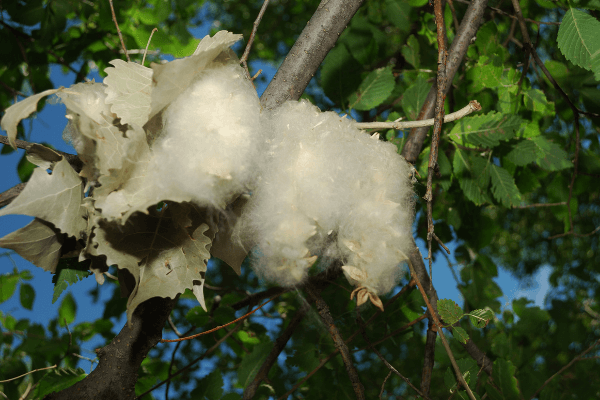
The Fremont Cottonwood can be found throughout the southwestern United States and into northern Mexico while the Black Poplar is native to Europe and western Asia.
Cottonwood trees grow very fast making them desirable for timber production.
Some cottonwood trees have been known to add six feet or more in height every single year!
The fibrous wood is used for shipping crates, pallet boxes and pulp for magazines.
However, the wood is not the only valuable part of the tree.
Cottonwood sap is traditionally used in folk medicines as well as herbal remedies like massage oils.
Native American tribes once used cottonwood sap as a sweetener in teas, syrups, and even puddings (I’ll stick to my maple syrup, though, thanks!).
The trees are also commonly planted as shade trees or used as windbreaks.
Cottonwoods prefer moist soil and they usually grow along ditch banks and the bottom lands of rivers and streams.
How To Identify A Cottonwood Tree
You’ll usually be able to tell the tree by its seeds alone, but if it’s not the right season for this, you’ll be able to identify a cottonwood tree by its broad, ash colored trunk.
The bark is has long deep ridges, is very think and is very rough.
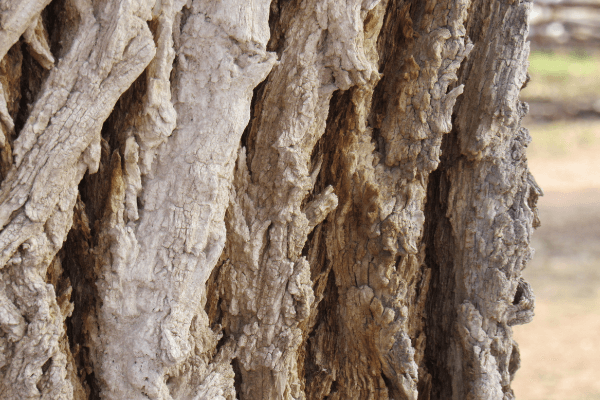
Its leaves are green in the summer and turn a vibrant yellow in the fall.
These leave are typically 3-4 inches in length, triangular in shape and have very distinctive curved teeth that line the outside border.
Cottonwood trees are some of the biggest hardwood trees found in North America, Europe and portions of Asia.
Usually, cottonwood trees are grown in places that, again, receive lots of moisture as well as full sunlight.
Cottonwood Firewood Usage
A visitor to our website had this question regarding cottonwood:
"When cutting cottonwood I've found it's hard to split even when using a splitter. Is this a hardwood or softwood? I was told it's a softwood.
It's also full of moisture. Is it ok for firewood? Any help would be appreciated."
- Patrick (Cheshire, CT)
Cottonwood trees are classified as a hardwood even though the wood is relatively soft and not very dense.
Cottonwood firewood has a low BTU rating but that doesn't mean you can't use it for firewood, it just means it doesn't supply as much heat as other popular hardwoods like oak or beech.
Splitting And Seasoning Cottonwood Firewood
Cottonwood is very wet, stringy and heavy when green, which makes it hard to move and difficult to split.
When the wood is really wet it seems to absorb a maul or splitting axe rather than splitting apart.
I think you'll find it splits a lot easier once it dries out a little bit.
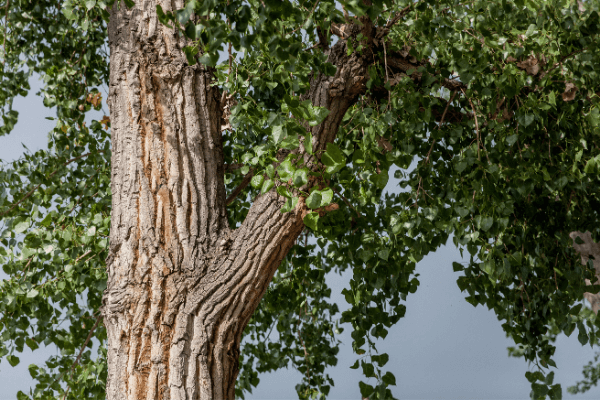
Since it's really wet when green I recommend letting the wood season 1-2 years after it's cut and split.
Once you have it split up, stack it off the ground and cover up the top portion of the stack if possible.
If you absolutely have to, you can stack your cottonwood firewood rounds for two weeks before you split and restack it, which will make splitting a bit easier, but I still recommend waiting before you decide to burn it (for reasons I’ll explain more below).
Another benefit of allowing your cottonwood firewood season longer is to make sure it stays nice and clean.
Unlike other kinds of firewood, like pine, that produce a ton of pitch and can gum up both your hands and your chainsaw, that’s not the case with cottonwood.
It’s known to be a rather clean wood.
However, there is still some mess to contend with when you’re dealing with green cottonwood.
These trees produce a fair amount of sap, which is why many people choose not to use cottonwood trees in their landscaping (the sap can really do a number on the paint of your car).
When you're transporting green cottonwood firewood, this is something you'll want to keep in mind.
The sap can make a mess of any surface you lay the wood on and it can usually only be removed with something as strong as WD-40 or fingernail polish remover.
Burning Cottonwood Firewood
A lot of people consider cottonwood completely worthless and won't burn it.
Some common complaints are the wood smells horrible when burning, it smolders and smokes and it creates minimal amounts of heat with a lot of ashes.
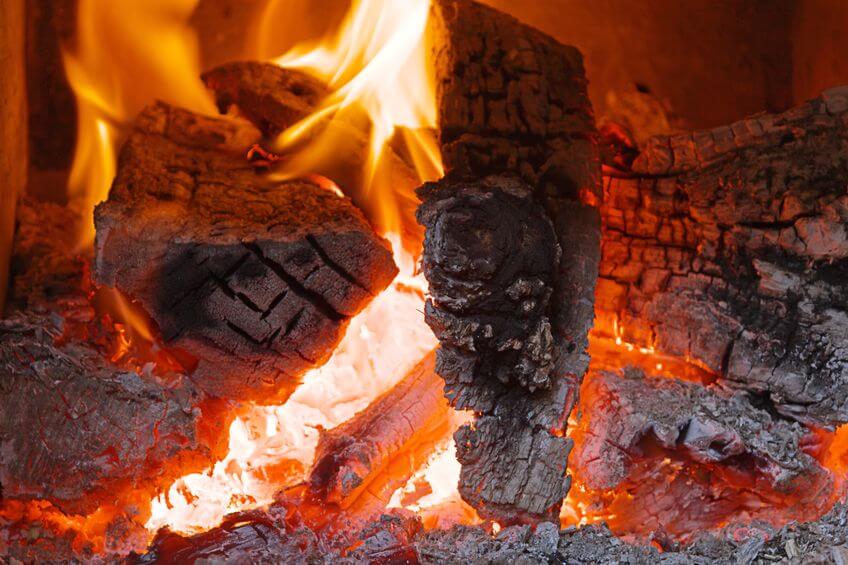
Although the wood does smell a little different when it burns I don't find the smell unbearable and I've had pretty good luck with cottonwood firewood.
However, the wood has to be dry.
If you try to burn it wet I'm sure you won't be happy with it.
Does Cottonwood Smell?
While most firewood types produce a smell that is similar to nuts, fruit or pine, cottonwood has the somewhat unfortunate reputation of smelling like cat urine.
I have never found that to be the case, but as with many types of firewood that are said to have a bad aroma, making sure you season the wood is key.
Seasoning the wood seems to help reduce any foul or unwanted odors.
When the wood is dry it splits pretty easy and makes good kindling.
It's also easy to light.
A couple of hot coals left in a wood stove from the night before will quickly light a dry piece of cottonwood.
Overall
If someone tries to give you a free load of cottonwood I definitely would not pass it up.
Over the years I think cottonwood has been misjudged by people who have never given the wood a fair chance.
Although the trees are usually huge causing the rounds to be heavy and difficult to move, the firewood it produces will definitely heat your home.
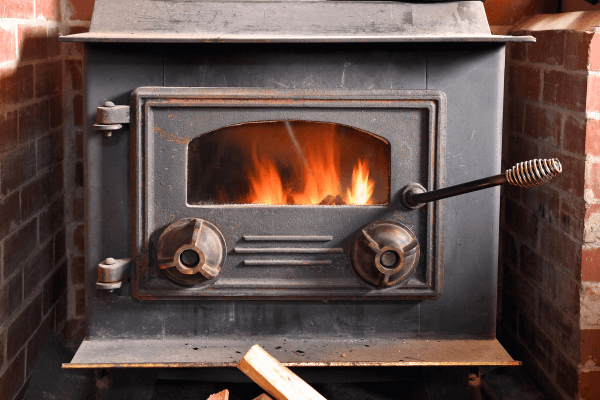
As long as you season your cottonwood firewood for a year or two, you shouldn’t have to worry too much about a lot of smoke, unpleasant smells, or sparks.
You also won’t have to worry about creosote buildup, which can lead to inefficient burning and increase the risk of a chimney fire.
Since cottonwood firewood is relatively clean to handle and lights easily when dry, I recommend using it.
It can also be found in most places in the United States so you won’t have to go to great lengths to find it.
If you’re truly hesitant about using cottonwood firewood, consider mixing it with another firewood type when you burn it - that way, you’ll get the best of both worlds.
Since it's lightweight when dry it does burn quicker than other hardwoods but overall it's a decent firewood choice.
Cottonwood will produce 15.8 million BTUs per cord.

About the Author
Obsessed with firewood, Nick is behind over 350+ of Firewood For Life's articles, as well as countless reviews, guides and YouTube videos to help readers like you reduce heating costs and create the perfect fire.


